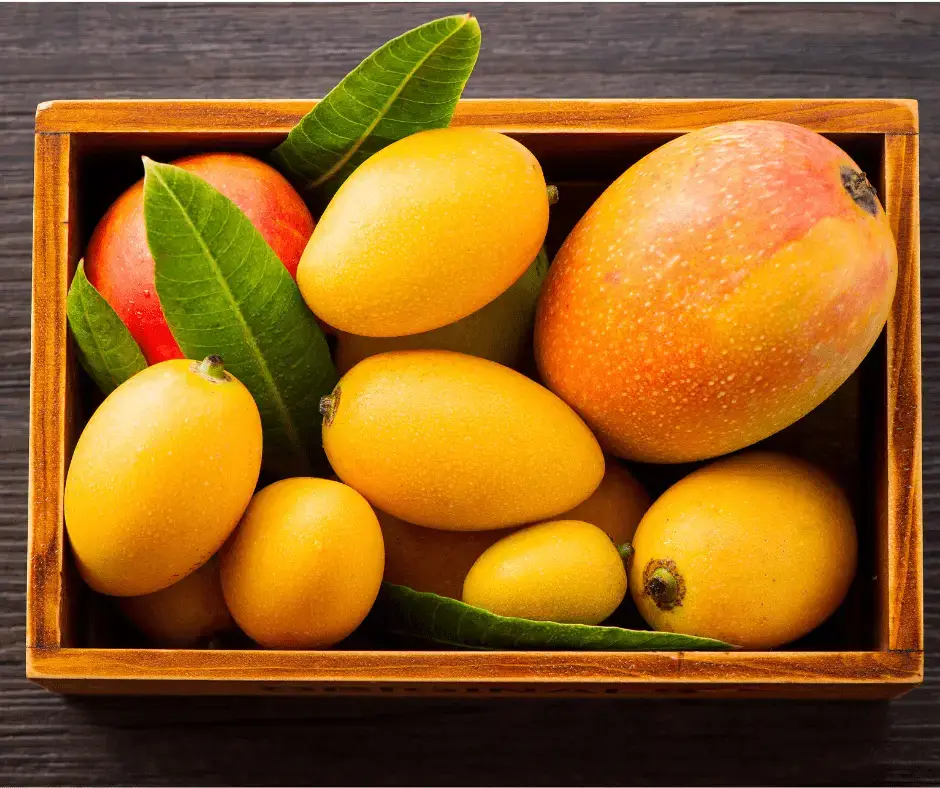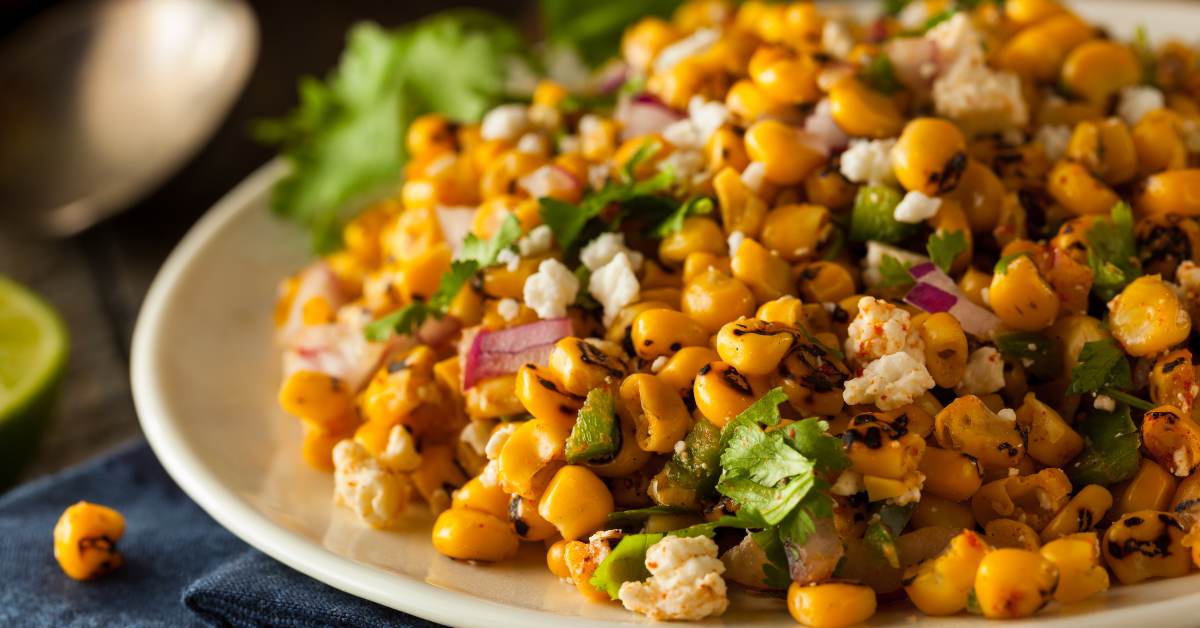Knowing how to properly store mangoes can be a challenge.
So today, I want to address those points of confusion and answer some questions! By the end of this post, you’ll know how to make your mangoes last even longer with the proper storage.
Can You Store Mangoes in the Refrigerator?
While many fruits can be stored in the refrigerator, it’s best to keep mango in your fruit bowl or stored at room temperature. Tropical fruits such as mango are more sensitive to chilled environments.
If you store your mangoes in the fridge, you’ll probably notice that it affects the quality of the fruit. However, once you cut up a mango, you can store any leftovers in the fridge until you’re ready to eat.
How to Store Mangoes in the Freezer
If you find yourself with a lot of mangoes and want to store them until ready for use, you’re probably wondering about freezing them.
Freezing is a great method to preserve fruit so that it can be enjoyed in the off-season.
Mango can be frozen in slices or mango pulp. It’s best to peel the mango and slice into chunks. Put in an airtight container or bag to avoid freezer burn. The mango can then be stored and taken out for smoothies and other recipes as desired.
How to Preserve Raw Mango for Long-Term Storage
Dehydrating
Mango can be easily dehydrated, and this is actually my preferred method. I mean…have you tried mango chips? Or mango candy? Delicious!
Check out these dried mango recipes for more inspiration.
It’s a good idea to blanch mango before dehydrating as this will preserve its color and keep it from turning brown.
Mango also has a high water content so it will take longer than drying other fruits in most cases. Most people prefer to slice mango thinly and then dry it. You can use a commercial dehydrator or do this in your oven if desired.
>>> You can even sun dry mangoes! Here’s how.
Canning
Canning mangoes is fairly easy and involves the same process as canning most other fruits. Since mangoes are high in sugar, they can be canned well but they need more acid to preserve them.
Usually, 1/4 cup lemon juice for every quart of mangoes is enough.
You’ll clean and slice the mangoes and then can them in a sugar syrup. This can be done in a light or heavy syrup depending on your preference.
A quart of mangoes takes about five to fill, depending on how tightly you pack them. You can use large or small mango pieces – just but be sure to remove the skin and the pit of the mango before canning.
Ideal Mango Storage Temperature
Mangoes are grown in a frost-free tropical country such as the Caribbean, India, and Africa. This means that you wouldn’t store them in the same way that you would other non-tropical fruits.
In general, they prefer a more humid climate, although this may not be possible depending on your location.
The best temperature to store mango is between 54-60 degrees F.
You should avoid storing them below 50 F in order to maintain their freshness. Since bruising the mangoes is fairly easy, make sure to store them without being covered by heavier fruit as this will cause them to break down quickly.
How to Stop Mangoes from Ripening
If you find that you have trouble with your mangoes ripening before you’re ready, you can actually slow down this process! For instance, hot water treatment gives you more time to use without changing their taste. It’s also a chemical-free option.
Here’s how:
- Warm two containers of water and use a thermometer to ensure that they are 52-55 degrees C.
- You’ll want to use a thermometer for precision as too hot or cold water won’t be as effective.
- Immerse the mangoes in the hot water and then leave for 10 minutes.
- Add more hot water from the other container if needed to maintain the temperature.
- After 10 minutes, remove the mangoes and cool them with running water.
- Air dry and then store until ready for use.
How to Keep Cut Mangoes from Turning Brown
Mangoes will start to darken when the surface is cut and they’re exposed to oxygen. While this does not affect their taste, most people prefer the natural yellow and orange look of the fruit.
There are a few ways to maintain the color of the cut fruit that you can do on your own:
Ascorbic acid (or Vitamin C) is an antioxidant that will prevent fruit from browning. You can use a crushed Vitamin C tablet or purchase ascorbic acid and mix with water.
Prices pulled from the Amazon Product Advertising API on:
Product prices and availability are accurate as of the date/time indicated and are subject to change. Any price and availability information displayed on [relevant Amazon Site(s), as applicable] at the time of purchase will apply to the purchase of this product.
Dip in mango slices quickly and it’ll stay orange.
If you don’t have any of this handy, you can use lemon juice to get the same effect. Toss lemon juice with the slices to prevent darkening.
Another option is using a sugar syrup. Submerge cut mango in sugar syrup or even fruit juice. This will keep it from darkening although it may alter the taste slightly.
Quick Tip to Still Enjoy Them When They’re Overripe
If you didn’t get to your mangoes quickly enough and they’ve become overly ripe, you don’t have to throw them away. One of the best options for ripe mango is to cut them up and puree the fruit.
You can freeze the puree and use it in smoothies, desserts, and other recipes. Use this when your mangoes are too soft to snack on plain!
How to Tell if a Mango Is Bad
Although mangoes don’t stay fresh for all that long how do you know if your mangoes have gone bad? One of the things to look for is their appearance.
Fruit that’s super soft and bruises easily usually means it’s overripe.
Ripe mango has a pleasant aroma but you may notice that your mangoes start to smell slightly off. These signs typically mean that you should discard the mango instead of trying to eat.
Frequently Asked Questions
1. Can mangoes be refrigerated?
Once the mango has been cut, you should store them in the fridge. However, uncut mango stores best at room temperature.
2. Where is the best place to store mangoes?
Storing them in a cool, dry place away from other fruits is the best storage method.
3. Why do mangoes turn brown inside?
Mangoes react to oxygen when they’re cut which turns them brown. You can prevent this with lemon juice or a sugar syrup.










